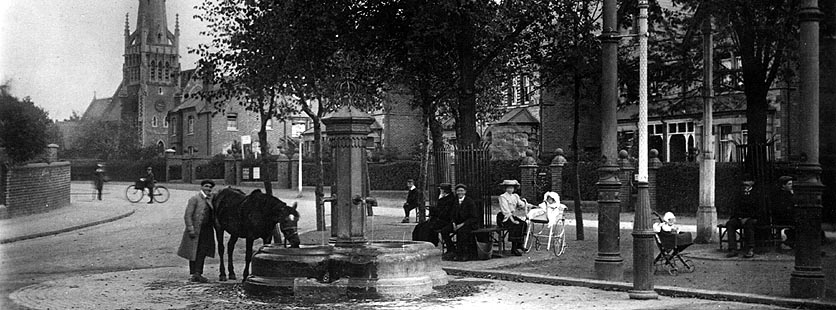 |
 |
|||
|
|
Whitley is the area of Southern
Reading, between the town and Shinfield, from the high ground alongside the Shinfield Road right down to Foudry Brook and the Kennet. The area around Northumberland Avenue is thought to be the home of Iron Age Reading. A large number of finds from that period suggests the existence of a hillfort that has since been obliterated by the housing.
Whitley was a Saxon hamlet settled on a small area of land cleared from the woodland on the edge of
Windsor Forest. The name means 'White Clearing,' perhaps referring to the local geology. The manor appears in the Domesday Book of 1086 as Witelei. Before the Norman invasion, it had been owned, along with other Berkshire manors, by a certain Edward. By then, it was held by Theodoric the Goldsmith. He was a German immigrant who had been living in London for some years, making jewellery for the Royal family. His chief country estate became Kennington in Surrey, but the Conqueror also gave him five wooded Berkshire manors where charcoal could be made for smelting metal. The main one was at
Hampstead Norreys, but he may have visited Whitley occasionally. Living there were two villeins (tenant farmers), two bordars (cottage dwellers), two serfs and their families. As well as the usual agricultural land, there were twelve acres of meadow (presumably along the Kennet) and a fishery.
In the 12th century, Whitley was given to the monks of Reading
Abbey. It was one of their closest manors and so a deer park was quickly established around the manor house in the 1160s. It was here that the abbot would entertain his guests with a day's hunting. The park and its house were up on the high ground adjoining the Shinfield Road, but there were also monastic granges on the manor, like Whitley Park Farm. Their produce was apparently collected at the
'long barn' that once adjoined the Four Horseshoes Pub at the junction of Long Barn Lane and the Basingstoke Road. The Abbey also had a
'conduit' on Whitley Hill, over a spring that supplied the monks with fresh water. After the Dissolution of the Abbey, Whitley Park was granted to various well-known Reading families: the Englefields, Knollyses and Vachells. They did not live there, but leased the place out to the Watlington family. Richard Watlington was at Whitley Park from around the 1560s and was Mayor of Reading, like many of his descendants. Some time before 1679, they rented the house to the Kendrick baronets. The first was a grandson of the philanthropist
John Kendrick's brother. The great heiress,
Frances Kendrick was the last to live there before moving on to
Calcot Park shortly before 1707.
A serious outbreak of plague visited Reading in 1638 and the Corporation decided that victims should be banished to specially built
'boarded houses' on the remoteness of Whitley Hill. Four years later, during the Civil War
Siege of the town, 'Harrison's Barn' on the same hill (now the corner of the Basingstoke Road and Christchurch Road) was made a Royalist outpost from Reading's main defences, along this major southern route into town. Many soldiers were stationed there. They dug huge banks and ditches with diamond-shaped bastions around it. It would have been the first place to fall when the Parliamentary army overran the town. It seems likely that the great house at Whitley Park was destroyed at this time and may not have been rebuilt until the Kendricks took on the estate.
Whitley remained a series of scattered farms and cottages until the 18th century, when proper hamlets began to emerge along the road from Basingstoke into Reading: around the
'World Turned Upside Down' at the Manor Farm Road junction and further north near the Bourne Avenue junction. The local pound for lost cattle and smithy were near the World Turned Upside Down. Great and Little Lea Common & Whitley Wood Common, in the south of the manor, were enclosed in 1858. Christ Church was built in 1861/2 by architect, Henry Woodyer, in order to accommodate the increasing congregation at
St. Giles'. By the 1870s, there was a small hamlet at the junctions of Whitley Wood Lane and Whitley Wood Road, and this is what grew to become what we today call
'Whitley Wood'. Country villas of the gentry also began to be built on the edge of Reading, south of the junctions of Basingstoke Road, Christchurch Road and Whitley Street: Whitley Lodge, Whitley Grove, Whitley Place and Whitley Hill (later called Whitley Rise). The area would eventually become known as
'Whitley Pump' after the popular watering hole that replaced the old conduit at the road junction (see photograph). By the 1890s, another hamlet was developing around the Four Horseshoes and, within twenty years, this had joined up with the houses spreading south from Whitley Pump. After the First World War, Reading contributed to the National campaign to provide council housing for the returning soldiers by building steadily over most of Whitley and Whitley Wood.
|
|||
| © Nash Ford Publishing 2001. All Rights Reserved. | ||||



